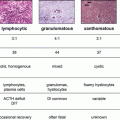© Springer Science+Business Media New York 2015
Terry F. Davies (ed.)A Case-Based Guide to Clinical Endocrinology10.1007/978-1-4939-2059-4_2828. Osteomalacia and Primary Hyperparathyroidism
(1)
Endocrine Unit 2, University Hospital of Pisa, Via Paradisa 2, Pisa, Italy
Keywords
OsteomalaciaPrimary hyperparathyroidismNormocalcemic primary hyperparathyroidismSecondary hyperparathyroidismVitamin D deficiencyHypercalcemiaCholecalciferolBone painObjective
– Diagnosis of osteomalacia
– Diagnosis and natural history of normocalcemic primary hyperparathyroidism
Case Presentation
A 60-year-old man was evaluated for severe vitamin D deficiency, associated with muscle weakness pain at the upper limbs and back lasting since 1 year.
His medical history included arterial hypertension, benign prostatic hyperplasia, bladder cancer treated with surgical intervention.
On examination, the patient appeared reasonably well. The BMI was 22, the blood pressure 140/80 mmHg, and the pulse rate 72 per minute. The neurologic examination revealed bilateral muscle weakness and hypotonia that affected the proximal shoulder and hip-girdle muscles.
His laboratory data were as follows (reference ranges are reported in parentheses):
Total albumin-corrected serum calcium = 8.2 mg/dl (8.4–10.2)
Serum ionized calcium = 1.05 mmol/l (1.13–1.32)
Phosphorus = 2.2 mg/dl (2.7–4.5)
Serum creatinine = 0.8 mg/dl (0.5–0.9)
eGFR = 108 ml/min × 1.73 m2
Intact PTH = 212 pg/ml (15–75)
25OHD = 8.5 ng/ml (>30)
Alkaline phosphatase = 280 U/l (40–129)
24-h urinary calcium = 100 mg (150–300)
Anti-transglutaminase antibody = <10 U/ml (<10)
Bone scintigraphy (TC99m HDP) showed an enhanced radioisotope uptake in the calvaria, ribs, clavicles, and spine suggestive of osteogenic process.
Bone mineral density (BMD) was decreased at the lumbar spine (T-score −1.6) and hip (T-score −2.4), and markedly reduced at the one-third distal radius (T-score −3.4).
Review of How the Diagnosis Was Made
The medical history and biochemical examination were consistent with the diagnosis of secondary hyperparathyroidism due to severe vitamin D deficiency and osteomalacia [1]. Vitamin D deficiency is the most common cause of secondary hyperparathyroidism. Patients with low 25OHD should be replaced with vitamin D and reevaluated. Occasionally these patients will become hypercalcemic, thus unmasking the more typical hypercalcemic primary hyperparathyroidism (PHPT). Cholecalciferol treatment was started (25,000 IU weekly for 8 weeks and subsequently 50,000 IU monthly). Three months later the patient’s general conditions and muscle function were improved and the bone pain decreased. Results of laboratory tests were as follows:
Total albumin-corrected serum calcium = 9.3 mg/dl
Serum phosphorous = 2.5 mg/dl
Intact PTH = 132 pg/ml
25OHD = 39 ng/ml
Alkaline phosphatase = 139 U/l
24-h urinary calcium = 180 mg
Neck ultrasound showed a right hypoechoic lump, posterior to the thyroid lobe, compatible with an enlarged parathyroid gland.
The finding of persistently elevated intact PTH despite normalization of serum calcium and 25OHD prompted us to further evaluate the patient. The normal urinary calcium excretion, and the negative history for liver and renal diseases, gastrointestinal diseases associated with malabsorption, other metabolic bone disease (e.g., Paget’s disease), and use of drugs (loop diuretics, bisphosphonates, and anticonvulsants) that could affect PTH levels raised the question that the patients might have normocalcemic PHPT (NPHPT) [2]. This entity has been recently described in women evaluated in their early postmenopausal years for parameters of skeletal health, as well as a consequence of measuring PTH in all subject undergoing evaluation for low BMD [3].
Stay updated, free articles. Join our Telegram channel

Full access? Get Clinical Tree




